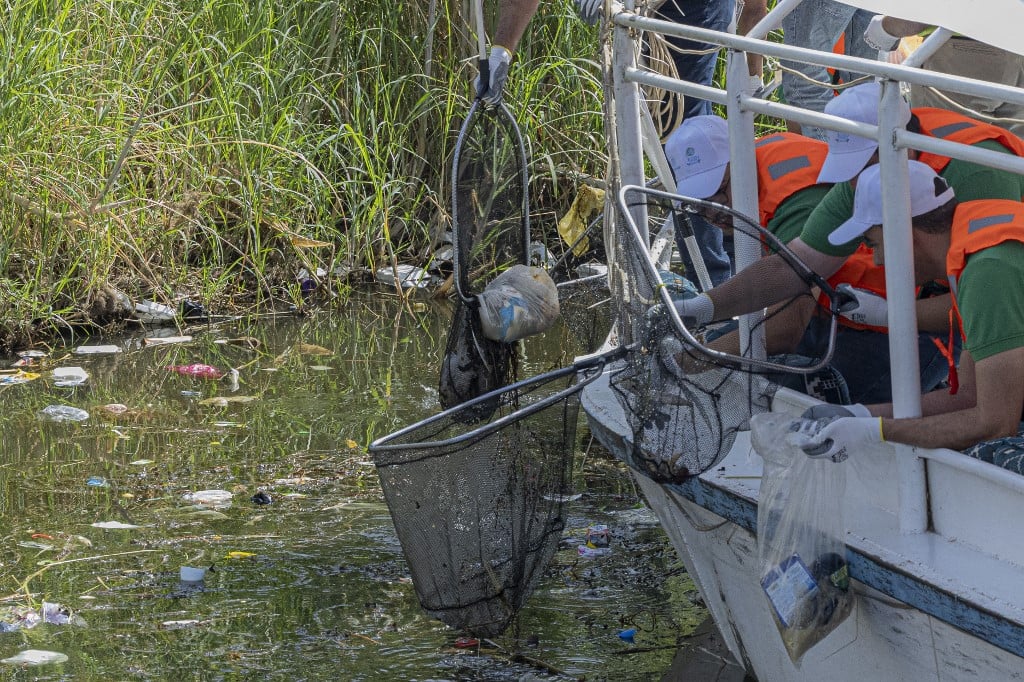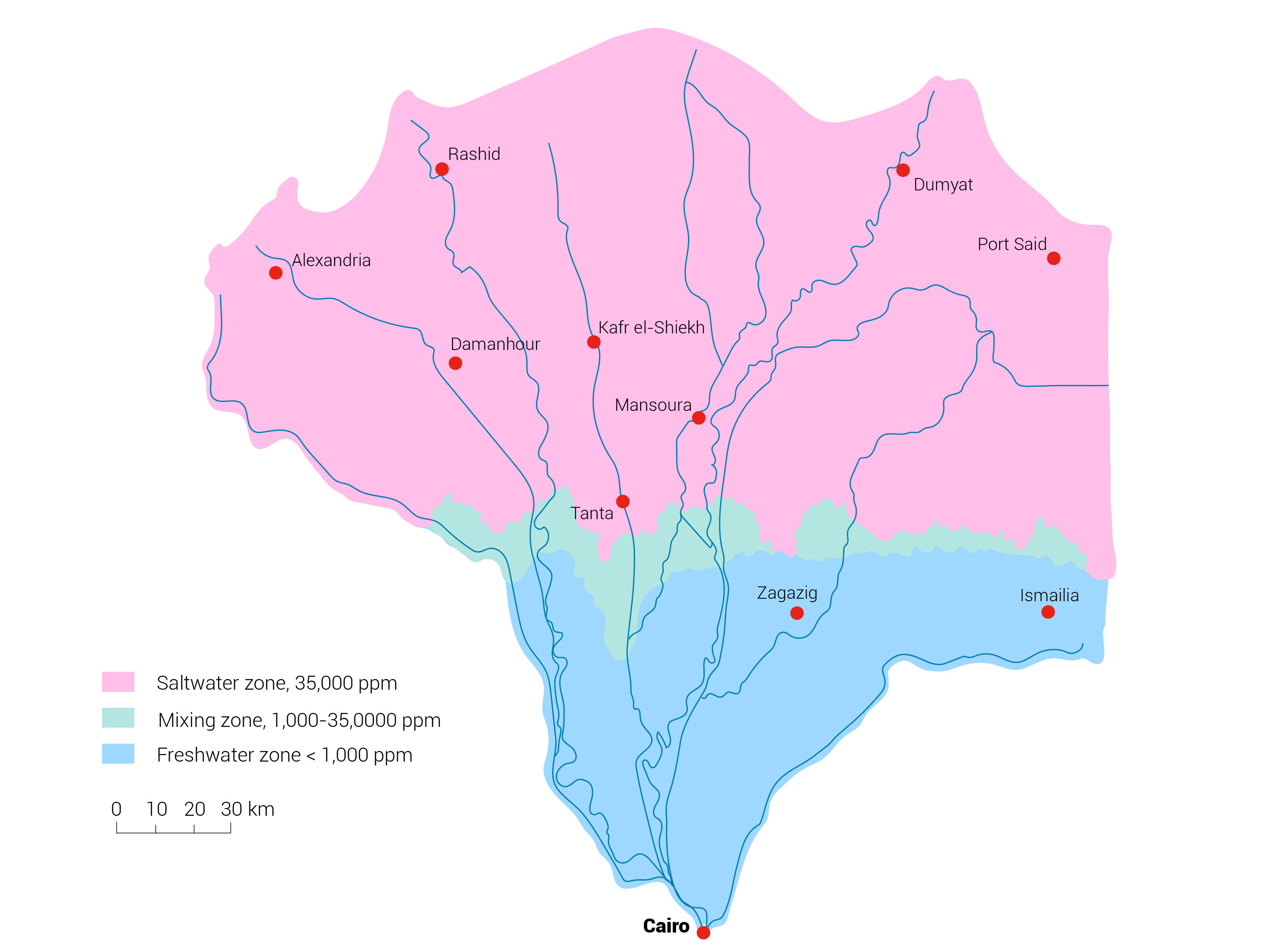
River Nile
To say that the consequences of water pollution in Egypt are harmful is an understatement, as the country has struggled to obtain clean water. Because the Nile provides water to the majority of Egypt, the fact that the river is constantly polluted with massive amounts of components such as sewage, poisonous chemicals, fertilizer residues, radioactive waste and oil pollution is potentially disastrous.
The pollution of the Nile is one of the most serious issues impeding Egypt’s development. According to recent studies by the Egyptian Environmental Affairs Agency, the Nile and its branches in the governorates have a severe pollution problem, with approximately 4 BCM of agricultural and industrial waste containing acids, organic materials, pesticides, agricultural and heavy metals discharged into the main stream each year.[1] Whereas the organic content of the river in Aswan is less than 1 mg/litre, it approaches 15 mg/litre in Cairo. Heavy metal concentrations such as iron, manganese and cadmium are less than 1 µg/litre in Aswan. However, iron and manganese concentrations in the delta reach 1,600 µg/litre and 220 µg/litre, respectively.[3]
Delta lakes
Anthropogenic activities and the influx of polluted water into the water systems in the delta region have led to increased concentrations of organic matter and chemical nutrients such as nitrogen and phosphorous. These have degraded water quality, increased algae growth and reduced the amount of dissolved oxygen in the water, resulting in the extinction of aquatic life and shrinking the water surface areas of the northern lakes such as Manazla, Edku and Burullus. This phenomenon, called eutrophication, has catastrophic economic and environmental implications.[4]
Eutrophication can also have a serious effect on a lake ecosystem’s ecological stability, affecting potentially all biological species and their interactions in the body of water. The fishing industry in the northern lakes fell from 40% in 2006 of Egypt’s overall fish production to 12.22% in 2021. This forced the government to implement a rehabilitation programme, spending around 7.8 million US dollars to rehabilitate Lake Mariout in 2022.[5]
Lake Nasser
Lake Nasser, a man-made lake, serves as Egypt’s national freshwater bank. Egypt recognizes that enhancing water quality management is an essential future means of addressing the issues of water scarcity and healthy water supply. Water quality management has therefore been identified as a critical development goal in government plans. The aquatic environmental index (AEI), which evaluates the quality status of water and aquatic life in water systems, revealed that the water quality in Lake Nasser is generally excellent, indicating that the water is suitable for industrial and drinking purposes. However, the AEI in the lake’s northern region declined to good, which is primarily due to the application of fertilizers and pesticides in agricultural areas and may indicate an occasional supply of polluting substances into the water body.[6]
Groundwater quality
The groundwater system in the delta region is severely exposed to seawater infiltration. This leads to decomposition and renders the water inappropriate for drinking or industrial use, reducing the region’s prospects of development. Climate change and sea level rise exacerbate the problem by allowing vast quantities of saltwater to penetrate the depths of the adjacent aquifers. Seawater has intruded inland to roughly 40 km in the middle delta and at the mean seawater level, followed by a 30 km transition zone (has a mix of groundwater and infiltrated saline water). The concentration of the salinity and the area of the saltwater and mixing zones increase at higher depths of the aquifer. At a depth of 300 metres, seawater has surged to Mansoura, which is approximately 70 km from the coast. The width of the dispersion zone varies between 40-55 km in the central delta.[2]
The groundwater quality in the Nile Valley is acceptable, although it is diminishing in many aquifers around the world, not just in Egypt. Pollution has impacted some shallow groundwater bodies, with approximately 20% of Nile aquifer groundwater failing to meet drinking water standards, particularly near the aquifer’s borders, where there is little or no protective clay top. The groundwater in the Nile Valley is often of higher quality than that in the Nile Delta.[7] Mahmoud [8] highlighted that infiltrating the river water into the adjacent groundwater system leads to a decrease in the concentrations of chemical and biological pollutants and substantially enhances the quality of the water. However, the discharge of untreated wastewater containing a high concentration of organic substances from septic tanks causes biological and chemical contamination of the aquifer, particularly in areas without sewage treatment systems.[9]
Environmental and health risks
A lack of integrated water management is aggravating health and environmental concerns across the country. Pollution of the groundwater system in Aswan in southern Egypt forced the authorities to close 76 wells that supplied drinking water to 1.2 million residents in 2009. This caused the groundwater table to rise by 20-25 metres within two years and water to appear on the surface, causing infrastructure damage and endangering inhabitants’ lives.[10]
[1] Abdalla, F., El Attar, R., et al., 2022, Contamination sources along the Nile Valley, Egypt and its impact on groundwater, in Sustainability of Groundwater in the Nile Valley, Egypt. Springer. 73-90.
[2] Sherif, M., Sefelnasr, A., et al., 2012.Incorporating the concept of equivalent freshwater head in successive horizontal simulations of seawater intrusion in the Nile Delta aquifer, Egypt. Journal of Hydrology, 464-465: 186-198.
[3] Al-Afify, A.D.G. and Abdel-Satar, A.M., 2022.Heavy metal contamination of the River Nile environment, Rosetta branch, Egypt. Water, Air, & Soil Pollution, 233(8): 302.
[4] Dorgham, M.M., 2011, Eutrophication problem in Egypt, in Eutrophication: causes, consequences and control, A.A. Ansari, et al., Editors. Springer Netherlands: Dordrecht. 171-194.
[5] Magdi, D.Z.G. After years of neglect, the dream came true and life returned to our water lakes. 2022; Available from: https://www.gomhuriaonline.com/Gomhuria/1124034.html.
[6] Rizk, R., Juzsakova, T., et al., 2020.Environmental assessment of physical-chemical features of Lake Nasser, Egypt. Environmental Science and Pollution Research, 27(16): 20136-20148.
[7] El-Rawy, M., Omran, E.-S.E., et al., 2022, Update, conclusions and recommendations for “sustainability of groundwater in the Nile Valley, Egypt”, in Sustainability of Groundwater in the Nile Valley, Egypt, A.M. Negm and M. El-Rawy, Editors. Springer International Publishing: Cham. 337-354.
[8] Mahmoud, A.R.A., 2021.Effectiveness of bank filtration for water supply in arid climates: A case study in Egypt. CRC Press.
[9] El-Rawy, M., Fathi, H., et al., 2022, Environmental impacts of treated wastewater contaminates on groundwater quality in the Nile River Valley, Egypt, in Sustainability of Groundwater in the Nile Valley, Egypt. Springer. 91-120.
[10] Abdelrady, A., Sharma, S., et al., 2020.Analysis of the performance of bank filtration for water supply in arid climates: case study in Egypt. Water, 12(6): 1816.

